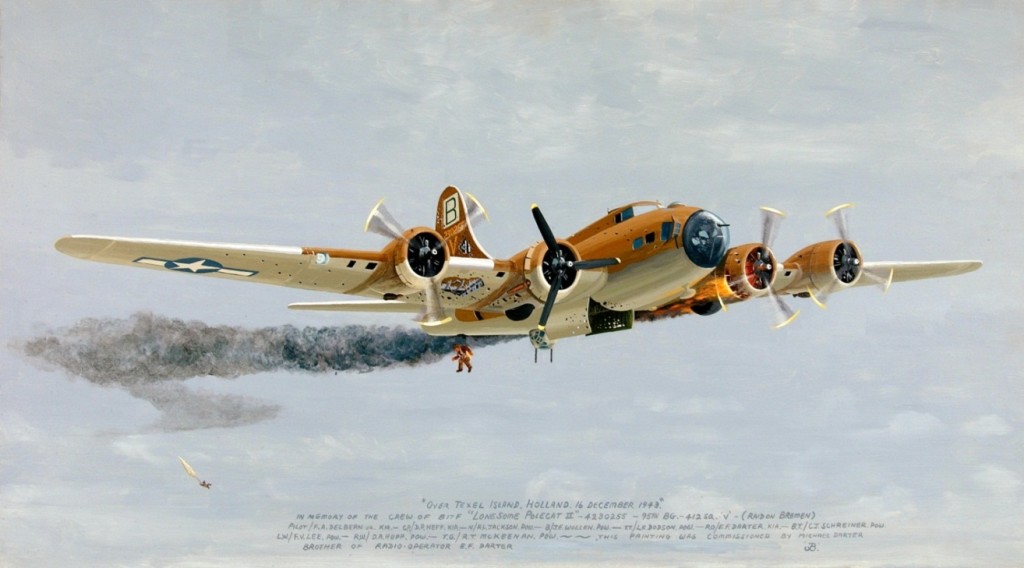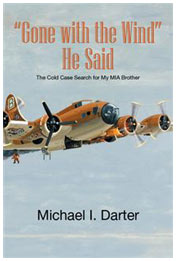
After the intense air battle with the Nazi fighters ended, the badly damaged and out of formation Polecat flew on due west, losing altitude. With three of the crew bailed out, pilot Fred Delbern steered the bomber towards the North Sea. He was wounded and co-pilot Don Neff was hit by shrapnel from a head on attack and likely dead. The five remaining crewmen in the back were all wounded as well.
They were now sitting ducks with only a few guns manned and they could have been easily blown out of the sky by enemy fighters. There was also the danger of blowing up in midair from fire in the two engines.
Luckily, they flew on over total cloud cover, and after about 30 minutes Doral Hupp came out of his ball turret and discovered my brother Eugene in a pool of blood on the radio room floor. Apparently, my brother had lost a one on one battle with a Nazi fighter as he manned his 0.5 caliber machine gun. “Darter had been lying on the floor helpless and this was the first breathing spell we had had for some time. Darter’s radio room was a mess and all the radio equipment was shattered, but we were still flying” related Charlie Schreiner.
At the same time, pilot Fred Delbern finally discovered that not all of the crewmen bailed out and he came out of the cockpit and talked to Doral who was applying a tourniquet to stop Eugene’s bleeding right arm. Delbern sized up the situation and orally gave the second bailout order that ‘the ship was to be abandoned immediately’.
As the five remaining crew members quickly prepared to bail out, they thought they were over the North Sea and would surely die quickly from hypothermia. Doral had Eugene standing now and had brilliantly snapped his chest chute upside down so that he could pull the chord with his only usable hand. Eugene, perhaps in shock and fearing that the burning #2 and #3 engines would explode, waddled past the other crew members and over to the rear door of the plane. He turned and gave a smile to the others, and turned and jumped out of the aircraft. The others, surprised, immediately looked out and saw his chute blossom as he descended into the total cloud cover below them. Doral had saved his life, at least temporarily.
Four other crewmen quickly finished getting ready and went out of the same rear door one by one. Charlie was the last on the plane (other than the pilots) and thought to himself, “should I stay on the bomber and die when it explodes or crashes into the North Sea, or should I bail out and die in the freezing sea… he hesitated, but then jumped through the door and out into the mist.
Before he went into the soup below, Charlie looked up and watched the Polecat fly on towards England, smoking and losing altitude. He wondered what the pilots would do, and then he went into the clouds below expecting to land in the North Sea and die…. But suddenly there was land below him and he hit the ground hard which knocked him out for a few minutes. When he came to, Nazis were upon him and they took him prisoner.
Later that evening, he met Doral, and Bob, and Frank in the nearby prison. All four survived but became POWs for the next 18 months. They were told they had landed on a Dutch island called Texel and their lives had been miraculously saved. Charlie had landed only a few hundred feet from the North Sea and certain death.
The crew never saw Eugene or Fred or Don again, they had vanished! The B17 Polecat was seen by a German ace high above, and he reported it to have crashed near De Koog village. No one came out of the wreckage out in the North Sea water as it sunk… later the German intelligence told Charlie that two bodies were found in the plane, which was of course the pilot Fred Delbern who had amazingly flown the burning and severely damage bomber so far, saving all but two of the crew, and the copilot Don Neff who was already fatally shot in the cockpit.
Decades later, two Dutch men on Texel now in their 70’s read a local newspaper article about a bomber on fire who had passed low over their village of De Koog on Texel and realized they have seen that aircraft as young boys. Cees Bonnie and Michele Binsbergen were with their fathers in the nearby village of De Koog when they were frightened out of their wits by a low flying bomber that nearly came down in their village, but flew just over their rooftops, over the large dunes and beautiful beach, turned sharply south and crashed into the North Sea just off the beach. They were shocked of course, and they never forgot this. After reading the article written by the brother of one of the crew (that’s me), each of them wrote detailed letters describing what they had seen.
The four crew members who landed in Texel were thankful to be alive, but they can’t help but wonder what happened to their crewmate Eugene Darter who had bailed out just before them. He did not show up at the Texel German prison that night, or in Frankfort for interrogation, or in the Stalag 17B POW camp in Austria. They talked and prayed that he was alive somewhere. It took over six decades to find out his fate.
